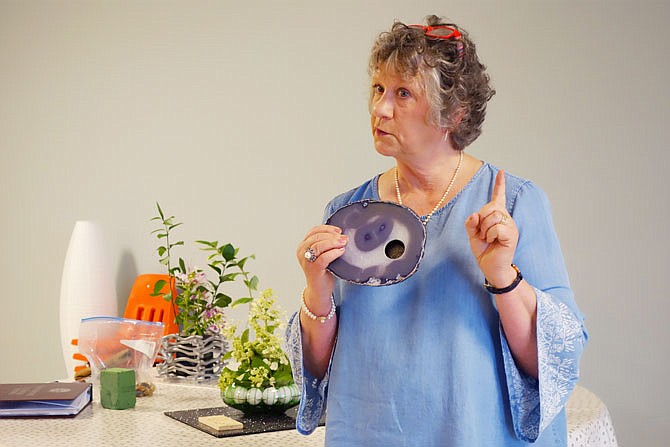Entering a flower show is serious business, according to flower show judge Carolyn Oates.
"At one show, I cut a lantana," she told Fulton Garden Club members Thursday evening. "It should have been fine. But it was (drooping). I pulled it before the show even started. It wasn't worthy of being shown."
Here's how to enter the Fulton Garden Club's upcoming "Get in the Gardening Game" flower show - and come out a champ, not a chump. The flower show is from 1-5 p.m. July 13 at the Callaway Electric Cooperative (1313 Cooperative Drive, Fulton). Entries will be accepted from 2-4 p.m. July 12, or 7:30-9:30 a.m. Friday at the co-op. Entering is free and open to the public.
Get ready
Flower show chair Linda Houston explained one important ground rule. All plant materials must be home-grown, which means they must have been in your possession for at least 90 days - though bulbs are a bit of an exception, so long as you sprouted them yourself. First, look to your yard.
Second, pick the sections and classes you want to enter. There are two broad sections: horticulture and design. Horticulture involves displaying single blooms (or sprays, etc., depending on the class). Design involves arrangements.
The array of classes is dizzying. Under horticulture, there are a number of specific classes for different annuals and perennials, plus catch-all "not listed" classes for each. Several have sub-classes, such as single vs. double cosmos.
Under display, there are three sections, each associated with a different type of award. Each class comes with design specifications and size limits. Exceeding or way undershooting those limits loses points.
Section A, "Game Winners" is where you find large, bold arrangements of blooms and greenery. Section B has several types of table arrangements. Section C is for miniature and dried arrangements.
For complete descriptions of each class, call Houston at 573-489-8309 to request a copy of the flower show booklet.
Each participant may only enter one entry per class or subclass.
Third, do some pre-planning. Take extra-good care of plants you might want to enter. Also, make sure to identify each plant you wish to enter, because that information is required on entry cards. You'll need to include the scientific name, common name and variety or cultivar, if applicable.
"It's kind of an educational tool we use, if people want to grow it themselves," Houston said.
For design categories, begin sketching potential arrangements and amassing materials. Creativity, or distinction, is encouraged and even earns you points with the judges.
Oates and Houston each brought examples. For "Hole in One," which requires using only one plant, Oates placed golf balls inside a miniatures Slinky and coiled it into a wide glass vase. In the middle, she heaped white hydrangeas. Many classes are sports-themed, and expressing that theme may earn points in the expression category.
"Visit the dollar store," Oates advised. "You can find (floral foam) there, you can find stones, you can find all kinds of things."
Houston showed off what you can do with modern materials in the "On the Links" class, which requires arranging greenery with "creative line mass design." That means leaving negative space, grouping the greens and using a strong line to draw the eye. She bent a piece of metal into a curlicue and placed her greens in magnetic metal vials along its length.
Get set
As the flower show approaches, Oates recommends practicing conditioning your plants - that is, making sure they stay in the peak of perfection after being cut.
"Play with it," she said. "Some say put a little sugar in the water, some say put a little aspirin in the water, some say get the packets from the flower shop. Find out what works for the individual plant."
Oates often seeks advice online, because different species may have very different requirements. For example, hydrangeas can be shocked by dunking them in boiling water and then cold water.
"Conditioning is incredibly important," she said.
Houston said most participants cut their flowers late in the evening before or early in the morning of the show.
Presentation is important in the horticulture division. Each bloom is displayed in a bottle or slim vase, so find one that coordinates well with the flower.
Go
When the time comes, carefully transport your entries to the Callaway Electric Cooperative. For fragile blooms or those with messy pollen, Oates said putting each stem in a length of pool noodle and setting them in a bucket can help.
She also emphasized a clean presentation.
In horticulture, grooming is worth 10 points - so make sure every leaf and bloom is free of blemishes, dirt and stains. She uses q-tips and paintbrushes to painstakingly remove dirt. However, spritzing leaves to make them shine or dyeing flowers and foliage is strictly forbidden.
Your bottle should be clean, too.
"There is no excuse for dirt on a bottle," Oates said.
Carefully prop each bloom into the perfect position, using unobtrusive items such as clear gel beads, clear marbles, or a wedge of clear cellophane warp in the bottle's neck.
Grooming is important in design as well, so make sure to wipe down the table around your design.
Ensure every entry has an entry card, obtainable during drop-off.
All the rules and details might seem a little overwhelming.
"I say the word 'judge' and that sounds harsh," Oates said. "The first and foremost reason to have a flower show is to educate the public."
After all your hard work is done, you can kick back and peep at everyone else's entries - and start planning for next year.

